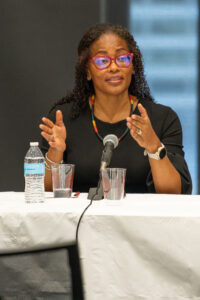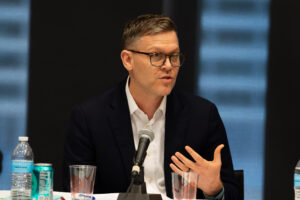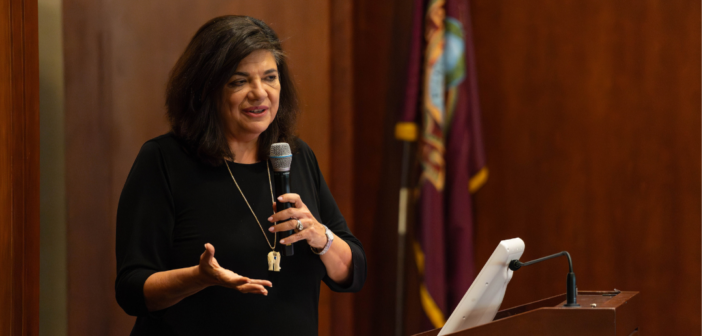To a crowd of over 50 child welfare professionals, Fordham GSS Professor and Mary Ann Quaranta Chair for Social Justice for Children Shirley Gatenio Gabel, Ph.D., outlined the three main areas of children and family services that led to the formation of the social work profession:
- Social caseworkers
- Settlement house workers
- “Child saving” from orphanages, communities, and families
When these three “streams” conjoined, Gatenio Gabel said, social work was the result. However, differing priorities left many unresolved issues, which have had downstream effects on the systems’ infrastructure and the profession.
Moreover, the issues have caused a declining interest in children and family services among young social workers.
“In the 1960s, over 50 percent of social workers worked in child welfare. Now, less than 33 percent are,” Gatenio Gabel said. “New social workers enter the system, and they don’t want to be there. In a field we once ‘owned,’ there have been so many changes.”
Gatenio Gabel gathered child welfare professionals from the Administration of Children’s Services, the New York Foundling, Hunter College, and the JCCA of New York on March 13 to discuss this exodus and its solutions in an event titled “Charting the Next Chapter for Social Workers in Children and Family Services” at Fordham’s Lincoln Center campus.
Burnout Leads to Turnover
Child welfare agencies are seeing extreme burnout among staff, which leads to a high level of turnover. This, in turn, has a negative impact on the children and families seeking help.

Ron Richter
Ron Richter, Chief Executive Officer of the JCCA of New York, said consistency is key to positive outcomes for children and families. If an organization’s staff suffers from burnout and hiring is a revolving door, it leaves children and families in the lurch to constantly make new connections. Richter said this can degrade trust, which hurts family-staff relationships.
“But there’s no societal imperative to support our work,” Richter said, commenting on federal and state governments’ lack of funding for these programs.
The issue of poor funding is combined with a more diverse and heavier caseload than ever before, said New York Foundling President & CEO Melanie Hartzog. Since starting her tenure at the Foundling three years ago, she’s seen poorly streamlined workloads and a lack of internal professional development opportunities.
“Just because you’re a great social worker, doesn’t mean you’re a great manager,” she said. “We need to invest more in management training for leadership teams.”
Hartzog continued by addressing the problematic issues of the agency payment structure. Payment doesn’t reward longevity in these organizations. Workers, realizing this, head elsewhere.

Melanie Hartzog
“In city government, you get paid based on longevity. In a nonprofit, your contract stays the same for three years. Someone who comes in [during]your third year can get paid the same as you. Why would you continue?” she asked the room. “How do I retain people if I can’t pay them for the work they’re doing?”
Let’s not forget: even if five different caseworkers can establish enough trust with a family to receive valuable information about their situation—as each caseworker leaves, some information will inevitably be lost. Transitioning to a new staff member is noisy and imperfect, and important details can get overlooked. Multiplied by five, the delta between what’s known and lost grows large.
“Each time a caseworker leaves, they take a piece of the story with them that hasn’t been told,” said Tricia Stephens, Ph.D., Associate Professor for the Silberman School of Social Work at Hunter College. “Who is the keeper of the continuity of the families we work with if five caseworkers in one year is common?”
Where do Social Workers Belong?
Less than 10 percent of child welfare agencies require staff to obtain a social work degree, Gatenio Gabel said. If social workers aren’t delivering the services, are they needed in this field?
“The value social workers bring has to do with social justice,” Richter said. “The difference between college grad case workers and someone educated in social work is the concepts and value of understanding that there are ways to help a person advocate, be more independent, and develop agency. Social workers do that.”
“Social workers are vital,” said Jess Dannhauser, Commissioner of NYC ACS. “Folks who come to our system are deeply eager to get an MSW. ACS has supported over 250 staff to get their MSW [degrees].”

Tricia Stephens
Earning that degree can supply some intangible knowledge to help increase positive outcomes. A non-social worker may not have the skill set to take a macro-level, holistic view of someone’s situation, and assess how they can empower the person to advocate for themselves.
Stephens said she doesn’t expect her students to know everything when they graduate, “but I do expect them to know something different from when they started…and I know that they’re taking it back to their workplace.”
When Training Isn’t Enough
Since the 1980s, Gatenio Gabel said, the U.S. has invested a lot of money in training social workers to be equipped for the profession’s diverse challenges. However, she continued, the literature tells a different story—showing no positive correlation between social work training level and positive child outcomes.
“Why do you think we’re not seeing that correlation?” she asked the panel.

Jess Dannhauser
Dannhauser noted that while training is absolutely essential, it is not sufficient to produce success. He noted that agency culture can, at times, stifle staff members—limiting risk-taking and lacking the internal coaching that can build a successful culture.
“One of my favorite sayings is, ‘culture eats strategy for breakfast.’ Well, it eats training for lunch,” Dannhauser said. “We have to undo these systems that we’ve built…That is the place where we need to put our heaviest emphasis—in changing the culture.”
However, the panel agreed that no matter how good the culture is, systemic barriers prevent positive outcomes.
“It’s not just about structural racism in child welfare, but racism overall,” Hartzog said. “There’s bias in each of us, and it shows up in many ways. How do we tackle this from leadership to the front line?”
Hartzog continued that the financial assistance from the government in the early stages of the COVID-19 pandemic was a step in the right direction. However, things returned to the status quo once the virus was under control.
“We reduced child poverty during COVID because of two things: we gave them a child tax credit and gave them money for food,” she said. “To know what works and then sit here and have the same conversations is frustrating.”
How Do We Move Forward?
After identifying some of the main issues within these systems, one question remained: What do we do now? Obviously, systemic issues need to be addressed, but we cannot stop helping those who need services in the meantime, Gatenio Gabel said.
Dannhauser believes that a way forward for his organization is to continue supporting staff members’ ongoing education as social workers.
“I don’t think we should do it just so they stick around longer. It’s an investment in, more broadly, system change,” Dannhauser said. “And if they end up in a different place and are changing the system, we should trust that that is an investment across our community.”
Stephens followed that she would enjoy a “smaller, leaner, more effective” ACS, and Hartzog again addressed the issue of urgency. She said that the swiftness with which organizations moved at the beginning of the pandemic was proof it can be done.
“Even within these systems, I tell my staff, ‘If not us, then who?’” she said. “We have to find a way to work within, but also push for these changes—but with urgency. I cannot say that enough.”
Richter closed the panel with positivity and optimism. He believes younger generations are primed to make change.
“Young people come to our agencies and have tremendous energy to advance the interests of children and families, and are raising a lot of the concerns you’ve heard tonight,” he said. “I want to believe we will adapt to the reality described tonight…Every parent loves their kid and wants them to succeed if only they had what they needed to make that happen. The same about people who do this work; it’s a parallel process.”
Want to watch the event in full? The recording is live on YouTube.



